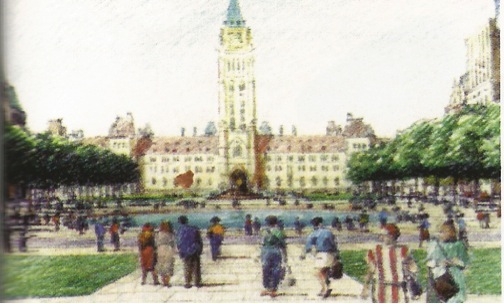
Bizarre Bylaws: It’s okay to ride your bike, but don’t Speed or coast
By David DuCharme
The City of Ottawa recently celebrated the 150th anniversary of a meeting by Bytown council on September 18, 1847 to choose a mayor of the town. This enactment gave council the power to enact laws and regulations for the internal government — known as bylaws.
The town, which had only been incorporated through an Act of Parliament on July 28, 1847, could now collect its own "taxes" and set regulations through bylaws. The September anniversary is an occasion that Ottawa has the unique opportunity of celebrating again in the year 2000 — because in October 1849 town council was notified that the Act establishing itself had been vetoed by the British government, consequently making void all acts, proceedings and bylaws. Hence, as mentioned last month, the record of official bylaws began in 1850.
A lot has obviously changed in the city of Ottawa in those 150 years. Not just physical changes but, as City of Ottawa Archivist Louise Roy-Brochu mentioned, the bylaws "are the greatest component and reflection of the city's social development. The bylaws are a wonderful example of the evolution of urbanization." Urbanization! In taking a close look at early bylaws, however, it appears that we've come full circle. Today, bicycles apparently rule the road and those fuel-sucking, exhaust-blowing motorized vehicles are the blotch on society. And in 1896, bicycles were the growing mode of transportation — inner-city alternatives to those hay-sucking, fart-blowing horses. And their use was growing to such an extent, that a bylaw had to be enacted and yet amended. Bylaw No. 1655 (the actual number of bylaws passed since 1850) established the regulation that "no person shall ride, drive, or propel a bicycle . . . at a rate of speed greater than eight miles an hour on any street within the said city" Bicycles also had to be equipped with a bell to be sounded within 50 feet of any crossing or when about to pass a vehicle traveling in the same direction. Although it doesn't mention the cost of the fine, try riding your bicycle today through the ByWard Market and see how much money you go home with. Oh, and thirdly, "no person riding a bicycle on the streets . . . shall indulge in the practice of 'coasting'. (?!?)
In 1908, the City of Ottawa appointed an Inspector of Cinematographs. Part of the inspector's job was to examine the person operating one of the motion picture projectors or cameras as to "his fitness" to operate such a machine. Bylaws are a good indicator for the rate of inflation and types of work for the time. For instance, in 1908, a bylaw was set for the "fair wages schedule". For the "tradesman", the stonecutters, plasterers, bricklayers and masons were the highest paid at 55 cents an hour. A driver with horse and cart made 35 cents an hour. In 1930, marble and tile setters got the top wage with $1.25 an hour. Stonecutters and plasterers got $1 an hour. That driver with horse and cart now made 70 cents and if you were the driver of a motor truck, it was 40 cents an hour. While the dredging of the river behind the Royal Canadian Mint for gold was contracted out this summer, in 1930 the city passed a bylaw to allow Louis Baker "the privilege of picking over the Corporation Dumps and removing the valuable refuse and junk therefrom, fur a term of one year." This one-year contract was apparently contracted out to someone different each year for a number of years. Nice work if you can get it, right?
Photo: Florian, Unsplash












